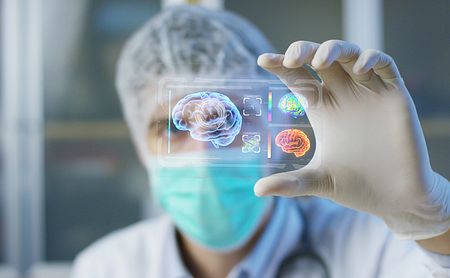Algorithm May Make Deep Brain Stimulation More Adaptive Process

An algorithm that detects and removes electrical interference produced by deep brain stimulation (DBS) devices could make it possible to design adaptable devices that better treat the tremors related to Parkinson’s disease, researchers report.
Their algorithm is described in the study “Uncovering biomarkers during therapeutic neuromodulation with PARRM: Period-based Artifact Reconstruction and Removal Method,” published in the journal Cell Reports Methods.
DBS is a form of neuromodulation therapy that delivers electrical pulses directly to the brains. This works to ease certain physical symptoms associated with Parkinson’s and other neurodegenerative disorders, including tremor, rigidity, and stiffness, as well as chronic pain. It is also used to treat the symptoms of certain psychiatric conditions such as obsessive-compulsive disorder (OCD).
One limitation of current DBS devices is that they cannot simultaneously sense disorder-related brain signals and adapt their stimulation activity accordingly. This capability would enable DBS devices to better identify biomarker signals and to adapt to a user’s needs.
A current device’s stimulation frequency can be adjusted to account for a patient’s evolving condition, but this must be done manually by a doctor.
“We know that there are electrical signals in the brain associated with disease states, and we’d like to be able to record those signals and use them to adjust neuromodulation therapy automatically,” David Borton, PhD, a biomedical engineer at Brown University and the study’s senior author, said in a university press release.
“The problem is that stimulation creates electrical artifacts that corrupt the signals we’re trying to record,” Borton added. “So we’ve developed a means of identifying and removing those artifacts, so all that’s left is the signal of interest from the brain.”
Since the artifact that a DBS device produces is an effect of the device itself, it varies relatively little from one use to the next. Borton and colleagues examined the average artifact signal over time and taught their algorithm, called Period-based Artifact Reconstruction and Removal Method (PARRM), to remove those signals from its detection program.
“We basically take an average of samples recorded at similar points along the artifact waveform,” said Evan Dastin-van Rijn, the study’s lead author. “That allows us to predict the contribution of the artifact in those kinds of samples, and then remove it.”
The research team tested their algorithm in a variety of conditions. These included saline (salty water that conducts electricity well), computer simulations, datasets collected from animal models, a dataset of 1,012 neuropsychiatric recordings taken from two OCD patients participating in an ongoing adaptive DBS clinical study (NCT03457675), and in data taken from different therapeutic stimulation settings.
In all cases, PARRM successfully separated signals from artifacts across a range of frequencies.
“I think one big advantage to our method is that even when the signal of interest closely resembles the simulation artifact, our method can still tell the difference between the two,” said Nicole Provenza, a PhD candidate in Borton’s lab and a study co-author. “So that way we’re able to get rid of the artifact while leaving the signal intact.”
PARRM, a computationally inexpensive application, can be run with existing DBS devices, being “easily adaptable to several neurostimulation paradigms,” the researchers wrote. According to the team, this real-time artifact filtering might enable simultaneous recording and stimulation.
“That’s the key to an adaptive system,” Borton said. “Being able to get rid of the stimulation artifact while still recording important biomarkers is what will ultimately enable a closed-loop therapeutic system.”
Although the researchers noted that more development is needed before PARRM might be used in a neurostimulation therapy setting, they believe that “artifact removal via PARRM will enable unbiased exploration of neural biomarkers that might have previously been obscured by stimulation artifacts,” they wrote.






